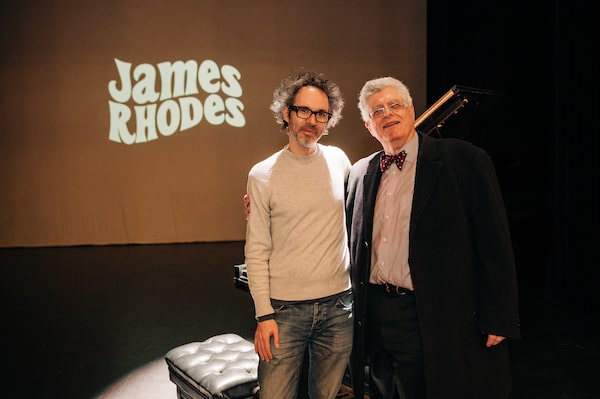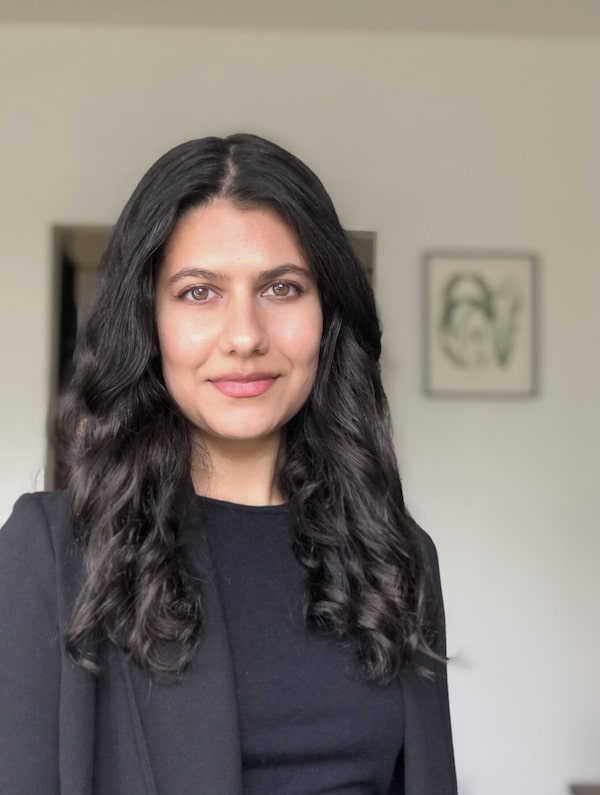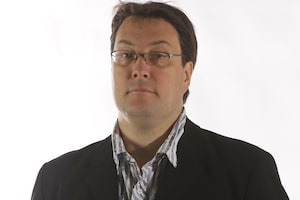
Brian Levine, right, executive director of the Glenn Gould Foundation, with British concert pianist James Rhodes, left, on March 4, 2020.Kenneth Chou/Handout
On rainy morning in 1968, the writer Joan Didion was driving from Sacramento to San Francisco with the radio turned way up. Listening to a Glen Campbell hit at high volume distracted her from the anxiety of crossing the Carquinez Bridge.
I hear you singing in the wire
I can hear you through the whine
With the music settling her worried mind, Didion managed to get where she needed to be. As she later wrote, “The Wichita Lineman was on the job.”
What Didion instinctively knew then and what therapists verifiably know now is that music isn’t just for entertainment. Science and health professionals tell us it can boost moods, provide opportunities for self-expression and help in developing coping strategies for stress.
In other words, music can get you across that bridge.
This week, the Toronto-based Glenn Gould Foundation launched Instrumental, a web-based project aimed primarily at teens. It’s designed to promote the mental health benefits of engaging with music at an intentioned and focused level. Developed with the input of educators, mental health professionals and music therapists, the interactive site articulates the importance of music and the arts as a supplement to other forms of care for young people.
“We know that being a teenager sucks,” says Brian Levine, executive director of the Glenn Gould Foundation. “There were always a lot of stresses on teens, and now the pandemic has added a sense of urgency.”
The foundation, formed in 1983, celebrates artistic heroes who, according to the organization’s literature, “exemplify the transformative impact of art on society and the human condition.” It is named after the great Canadian pianist.
In early 2020, the foundation brought in British concert pianist James Rhodes for a talk and a performance in Toronto. Rhodes had suffered horrific sexual abuse as a youth. His book Instrumental: A Memoir of Madness, Medication and Music documents the trauma and the role music played in his recovery. The foundation named its new mental health initiative after the pianist’s book.
“We wanted to generate a resource for teens that will pick up on the things in James’s memoir,” says Levine, speaking with The Globe and Mail on a Zoom call with Rudrapriya Rathore, a manager with the foundation. Rathore adds that the feedback they got from young musicians was that music gave them the space to be vulnerable. “It allows them to express difficult emotions,” she says. “And it’s what makes them feel connected to other people.”

Rudrapriya Rathore, a manager with the Glenn Gould Foundation, says that the feedback they got from young musicians was that music gave them the space to be vulnerable.Handout
In his book, Rhodes wrote that the Bach music he heard on a cassette tape as a child acted like a “force field” against distress. His case is an extreme example, both in terms of his prodigious abilities as a pianist and his deep trauma. (He attempted to hang himself in a psychiatric hospital.) What the Glenn Gould Foundation now aims to do is to show anyone that just listening to music (as well as playing or composing it) can help with understanding and processing emotional states.
In years past, pop music has routinely displayed an unsophisticated understanding of anxiety. In 1988, Bobby McFerrin sang his way to a Grammy Award with his “don’t worry, be happy” mantra, as if emotional well-being were that simple. Twenty-five years later, Pharrell Williams testified on his hit song Happy that “can’t nothing bring me down.”
While Williams apparently has a limitless supply of serotonin, most of us aren’t so lucky. Young people in particular are plagued with mental health issues. According to figures released late last year by the World Health Organization, one in seven 10- to 19-year-olds experience a mental disorder. Depression, anxiety and behavioural disorders are among the leading causes of illness and disability among adolescents, and suicide is the fourth leading cause of death among older teens.
In Canada, according to the Toronto-based non-profit research institute ICES, one in five children and youth experience a mental illness at any given time.
Where the carefree McFerrin is not a trained music therapist, Calgary’s Jennifer Buchanan is. She’s an advisor on the Instrumental initiative and she’s published the new book Wellness, Wellplayed: The Power of a Playlist. When she began her career in the 1990s, a lot of the science wasn’t in yet on how music affects the release of hormones and neurotransmitters and how that improves moods and helps memory functions.
But even without the hard scientific evidence to back it up, the utility of music was plain to see. “As music therapists who sat at bedsides in hospital settings, schools and correctional facilities back then, what we were recognizing was this impact of music,” says Buchanan, executive director of the Canadian Association of Music Therapists. “It wasn’t just the impact at a functional level, where we use music to retrain language with a stroke victim, for example, but it was so clear how much music was making people feel better.”
Jennifer Buchanan, an advisor on the Instrumental initiative and author of the new book Wellness, Wellplayed: The Power of a Playlist.Jodi O/Handout
The Glenn Gould Foundation’s new online hub is one of several programs that employ music as a tool. El Sistema (The System) was founded in Venezuela in 1975 as a free after-school music and social development program for children living in underserved communities. Today, El Sistema-based programs exist worldwide and across Canada.
The Winnipeg-based Make Music Matter was founded to help survivors of conflict in Africa. The organization often works with survivors of sexual violence. “We’re taking people who are heavily traumatized,” says Darcy Ataman, “and restitching their souls back together.”
Through the charity’s Healing in Harmony program, emotionally damaged people (often youth) are invited to play and compose music in recording studios built in hospitals. “There are traumas they can’t speak of because it will just destroy them,” says Ataman. “But they will sing about it, and they will write lyrics about it.”
Melodies and words can unlock the trauma in the brain, according to Ataman. He tells a story about a teenage rape victim in the Democratic Republic of Congo who would not bond with her baby. “People who have experienced trauma will reject the thing that reminds them of the incident,” he says. “We had a 15-year-old girl who literally told me she would never love her child,”
The girl wrote her songs within the Healing in Harmony program, which culminated in a community concert. The crowd’s reaction to her music was so joyful that the girl felt emboldened and socially accepted enough that she walked off the stage and picked up the baby for the first time. “It was such a perfect moment, and the behavior has stuck with her ever since,” says Ataman.
Because the Healing in Harmony treatment is not presented to the traumatized participants as therapy, the stigma of a formal session is avoided. The help is inconspicuous.
Programs such as Instrumental are more upfront in their approach. Mental health issues today are talked about publicly and more freely than ever. Look no further than to Billie Eilish and Shawn Mendes, superstar pop artists who have been candid about their anxiety. The new Instrumental project builds on that openness.
“It’s not self-diagnosis, but it’s important for teenagers to know there are coping mechanisms and self-care strategies that can help,” says Rathore. “We’re hoping this reaches the young people who need it the most.”
The website presents information on everything from vibroacoustic therapy (using sound waves) to articles on the teenage brain. “Music changes thing on a neurological level, and that process can be harnessed,” says Levine. “This is not subjective fluff. It is real medicine.”
BOOKS ON MIND AND MUSIC
The following books, in part or in whole, explore the relationship between music, mind and soul.
This Is Your Brain On Music, by Daniel Levitin (2006): The rocker-turned-neuroscientist breaks down how we listen to music and why we enjoy it.
Wellness, Wellplayed: The Power of a Playlist, by Jennifer Buchanan (2022): The Calgary-based music therapist explains the benefits to well-being of a mindfully made playlist.
Instrumental: A Memoir of Madness, Medication and Music, by James Rhodes (2017): The British concert pianist connects the healing of his psyche with the transcendent brilliance of classical music.
How Music Works, by David Byrne (2012): The Talking Heads maestro, polymath and adroit cultural observer argues for the liberating power of music.
The Healing Power of Singing, by Emm Gryner (2022): Life lessons from the Canadian singer-songwriter, single mother and David Bowie tour mate.
How to Write One Song, by Jeff Tweedy (2020): Write a single tune and “watch your concept of time evaporate,” says the Wilco singer-songwriter.
Sign up for The Globe’s arts and lifestyle newsletters for more news, columns and advice in your inbox.
 Brad Wheeler
Brad Wheeler